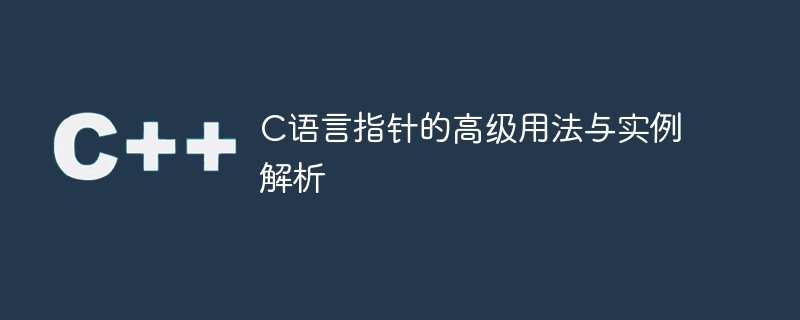Home >Backend Development >C++ >In-depth discussion of the usage and examples of pointers in C language
In-depth discussion of the usage and examples of pointers in C language
- WBOYWBOYWBOYWBOYWBOYWBOYWBOYWBOYWBOYWBOYWBOYWBOYWBOriginal
- 2024-02-19 11:08:06904browse

Advanced usage and example analysis of C language pointers
Introduction:
C language is a very low-level and powerful programming language, in which the concept of pointers is One of its core. In C language, pointers can be used to directly operate on memory, which makes C language highly flexible and efficient. This article will introduce some advanced usage of C language pointers and demonstrate their applications through specific code examples.
1. Review of the basic concepts and usage of pointers
In C language, a pointer is a variable that stores a memory address. Through pointers, we can directly access or modify data in memory. The following is a review of the basic usage of pointers:
-
Declaring pointer variables
When using pointers, you first need to declare a pointer variable. For example:int* ptr; // 声明一个指向整型变量的指针 int* ptr2, *ptr3; // 同时声明多个指针变量
-
Reference operator
&
Reference operator&is used to obtain the memory address of a variable. For example:int num = 10; int* ptr = # // 将num的内存地址赋值给ptr
-
Dereference operator
*
Dereference operator*is used to obtain the data in the memory pointed to by the pointer . For example:int num = 10; int* ptr = # printf("%d", *ptr); // 输出10,因为*ptr解引用指针ptr得到num的值
2. Advanced usage of pointers
-
Pointer of pointer
Pointer of pointer refers to a pointer variable pointing to a pointer. Through a pointer to a pointer, we can indirectly access the memory address pointed to by the pointer. The following is an example:int num = 10; int* ptr = # // 指针ptr指向num int** ptr2 = &ptr; // 指针ptr2指向指针ptr printf("%d", **ptr2); // 输出10,通过ptr2解引用连续两次,即可得到num的值
-
Pointers and arrays
There is a close connection between pointers and arrays. In fact, the array name is a pointer to the first element of the array. Through pointers, we can traverse and operate on arrays. The following is an example:int arr[5] = {1, 2, 3, 4, 5}; int* ptr = arr; // 数组名arr就是指向数组第一个元素的指针 for(int i = 0; i < 5; i++) { printf("%d ", *(ptr + i)); // 通过指针遍历数组并输出每个元素 } -
Pointers and functions
Pointers can also be used to transfer parameters between functions. By passing pointers, the passed variables can be directly modified inside the function. value. The following is an example:void swap(int* a, int* b) { int temp = *a; *a = *b; *b = temp; } int main() { int num1 = 10; int num2 = 20; swap(&num1, &num2); // 传递num1和num2的地址给swap函数 printf("%d %d", num1, num2); // 输出20 10,通过指针在函数内部交换了num1和num2的值 return 0; }
3. Summary
This article introduces the advanced usage of C language pointers and analyzes them through specific code examples. Advanced uses of pointers include pointers to pointers, pointers to arrays, and pointers to functions. Correct use of pointers can improve the efficiency and flexibility of the program, but you need to be careful when using pointers to avoid problems such as memory leaks or dangling pointers. I hope this article will help readers with their advanced usage of C language pointers.
The above is the detailed content of In-depth discussion of the usage and examples of pointers in C language. For more information, please follow other related articles on the PHP Chinese website!
Related articles
See more- How to center the html h1 tag? Analysis of examples of h1 centering in html
- How to implement the function of pointers in java
- What are the differences and similarities between pointers and references?
- Move the mouse pointer over something and drag to move the window position.
- 5 advanced uses to improve python efficiency

